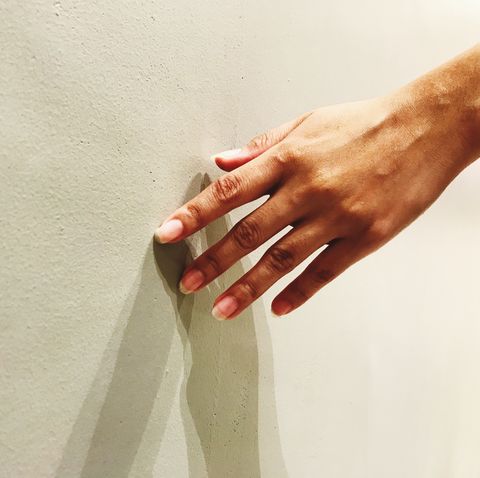How Do Animals Use Their Sense Of Touch

Sureeporn Threepola / EyeEm Getty Images
- Scientists from a French university have adamant that in some instances, the brain can treat sensory tools—such every bit white canes for the visually impaired—every bit extensions of our bodies.
- This sensory embodiment shows that even though nosotros know a tool isn't actually a part of our bodies, our brains tin treat it equally such—especially when it comes to direct sense of impact.
- This research could show pivotal in creating higher quality prostheses with heightened sensitivity to touch.
Imagine yous're holding a pen past the tip-side in between your thumb and index finger. You close your optics and enquire someone to tap information technology once on the reverse side. And so you ask them to tap information technology again, merely this time, the person taps closer to the middle of the pen. Think yous'd exist able to differentiate between the end and centre taps?
According to research led by cerebral neuroscientist Luke Miller and colleagues from the Claude Bernard Lyon 1 University in France, your chances of an authentic guess stand up somewhere near 96 percentage.
Although being able to extend your sense of touch through tools is possible, this particular field of science has been largely understudied. In 2018, Miller et al. published a study in Nature , stating that humans accept the uncanny power to very closely estimate where one object, like a finger, comes into contact with another object existence used as a tool, similar the pen, every bit long as the tool is in direct contact with skin.
More recently, Millet et al. published another paper in Electric current Biology saying that our brains treat tools every bit extensions of our bodies. This makes perfect sense especially when you consider a tool like a white pikestaff used by the vision impaired.
This content is imported from YouTube. You may be able to detect the same content in another format, or you lot may exist able to discover more data, at their spider web site.
In an experiment, Miller enlisted the help of 16 people and individually had them hold a three-human foot long wooden rod. Over the grade of 400 trials, each person was tasked differentiating whether or not two taps on the rod—either in the same spot or in two different places along the rod—by another person were close to their own hand.
If the subject felt that the tap was close to where their mitt was on the rod, they'd push a pedal with their foot to signal equally much. All 16 subjects were correct on their guesses a staggering 96 percentage of the fourth dimension.
Researchers noted that the cortex "quickly candy where the tool was touched," thanks to electrodes that monitored encephalon activity. Researchers were likewise able to deduce that sensory areas in the brain suppress responses to repeated stimuli (i.e.: ii taps). This suppression allowed researchers to create a "time postage stamp" that noted "when a stimulus is extracted in the brain."
The researchers then moved on to touching the arms of each bailiwick instead of the wooden rod and noticed that in that location was "similar repetition suppression in the same brain regions on similar fourth dimension scales," indicating that the brain can sometimes care for tools every bit extensions of our bodies.
This research could show pivotal when it comes to improving the quality of prostheses and overall quality of life for those who need them.
This content is created and maintained past a 3rd party, and imported onto this page to help users provide their email addresses. You may be able to find more than information about this and similar content at piano.io
Source: https://www.popularmechanics.com/science/a30361970/sense-of-touch/
Posted by: hernandezflery1974.blogspot.com

0 Response to "How Do Animals Use Their Sense Of Touch"
Post a Comment